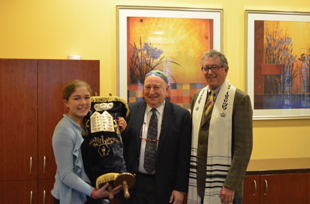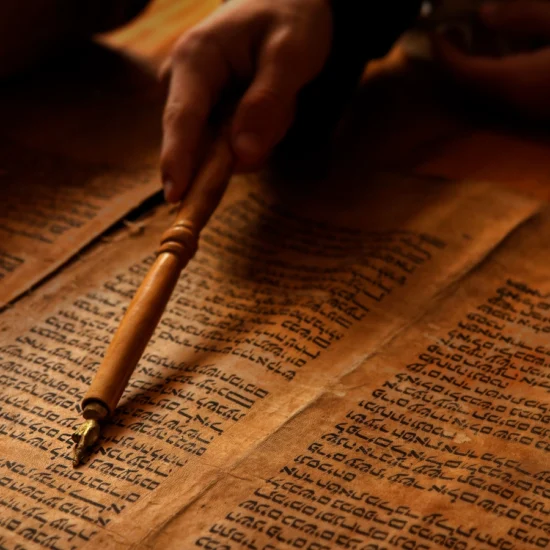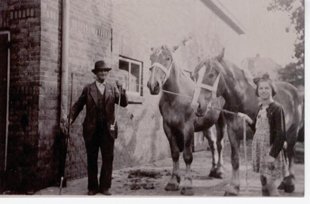By Paul Liberatore | Marin Independent Journal |
UNTIL RECENTLY, members of the Jewish community at Alma Via, an assisted living home in San Rafael, were without a Torah, the five books that make up the Jewish Bible.
Last month, a Torah was given to them, a very special Torah, a Holocaust Torah with a long and, at times, harrowing history, beginning when it was smuggled out of Nazi Germany in 1938.
“The Torah we’re using today, which my family is so very proud to bring to all of you, has quite a story,” 12-year-old Charlotte Smith told the congregation when it was dedicated at a Simchat Torah service in October at Alma Via.
It originally belonged to her great-great-grandfather, David Hamburger, a horse and cattle dealer in Fuerstenau, a quaint village in the countryside of northern Germany.
“The Jewish community in Fuerstenau was so small that it didn’t have a synagogue,” Charlotte began. “David was the leader of the congregation, and the Jewish families would come to worship in his home. Somehow — we don’t know how — the community had its own Torah, this Torah, which David kept safely in his home.”
On the infamous Kristallnacht, Nov. 9, 1938, the Nazis went hunting for Jews all over Germany. Neighbors and friends hid David in a hospital in town and, the next day, helped him slip back home to pack, knowing that he had to get out of Germany right away.
“He had to hurry and could only take a couple of things,” Charlotte told the seniors. “He took a few clothes, a portrait of his wife and, most importantly, the Torah. He then took a train to Holland, where his daughter was living.”
All during the war, Hamburger hid in the Dutch underground, going from one farm to another.
“At one point he was hidden in the home of a Catholic priest for 18 months,” Charlotte said. “In case you’re wondering, yes, he kept the Torah with him all of those years.”
Hamburger’s daughter, her husband and their twins, a boy and girl, were not so fortunate. Captured by the Nazis in Holland, they all perished in Auschwitz.
After the war, Hamburger decided to stay in Holland, where he enjoyed ice skating, bicycling and riding his motorcycle. It’s sadly ironic that after all he’d been through, he ended up being killed in a motorcycle crash in 1958 at the age of 75. After his death, his son, Siegfried, who was living in San Francisco, brought his father’s belongings back to the Bay Area, including the Torah.
When Siegfried died, his son, Steven, gave it to Rabbi Jerry Winston, who led a small congregation in San Anselmo.
“In quite a coincidence, my parents were married by Rabbi Winston,” Charlotte said. “And when I was 6 months old, he conducted a baby naming ceremony for me.”
As she got older, Charlotte started studying for her bat mitzvah. About a year ago, her mother, Julie Ann Kodmur of St. Helena, thought it would be a wonderful connection to her family’s history if the Holocaust Torah could be used for Charlotte’s bat mitzvah. But she wasn’t sure where it was.
As she began asking around, referring to it as “the lost Torah,” she learned that before Rabbi Winston died, he’d given it to his friend, Sausalito Rabbi Alan Levinson, who still had it. When she asked him if her family could borrow it for Charlotte’s bat mitzvah, Rabbi Levinson realized that it would be an incredible closing of a circle if the Torah was returned to the family that saved it.
“It’s a big thing, not a little book,” Charlotte’s mother said. “That’s one of the amazing things about my great-grandfather. For eight years, from 1938 to 1945, he took it from Dutch farm to Dutch farm where he was hidden. And he carried it with him the whole time. Imagine if it could talk.”
As she approached her 13th birthday, Charlotte was studying for her bat mitzvah with Rabbi Jerry Levy of Tiburon, who leads the congregation at Alma Via. Because the assisted living center didn’t have a Torah, Charlotte’s family thought it best if the Torah be used by Alma Via, and for Charlotte’s upcoming bat mitzvah.
“What a wonderful solution,” Charlotte’s mom said.
For Rabbi Levy, the Holocaust Torah is important to the family that saved it, but also as a symbol of something much larger.
“Every time a sacred scroll is saved, preserved and passed down,” he said, “not only from community to community, but also from teacher to student, from father to son, all of those things represent the strength of Judaism.”Contact Paul Liberatore via email at liberatore@marinij.com



